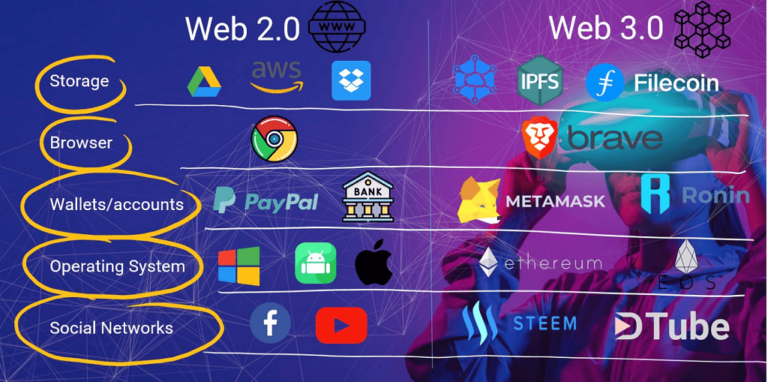Web 3 is here to save the Web 2 tech crunch. It’s like your favorite bag of potato chips just got better.
You love your V2 bag of chips but now V3 has zero calories with a prettier bag!
What does this mean? For example, you bought a premium .com domain. You are hoping to resell it for $1 million. However, you forgot to renew the domain and lost it to some shark who spends all day scalping domains from people who forgot to renew.
Well, Web 3 companies solve that with unstoppable domains. You pay ONCE and that is it! No renewal fees! Just like how your favorite V2 bag of chips has 0 calories in V3.
Let’s read on to explore the difference Web 2 vs Web 3.
Table of Contents
Web 2.0 and Web 3.0
Now that the cat is out of the bag let’s dip deeper into the Web 2 and Web 3 differences. Web 1.0 vs Web 2.0 and Web 3.0:
- Web 1.0 – read data
- Web 2.0 – read and write data
- Web 3.0 – read, write and own data
We are going to explain what web 3 online data is and how encrypted digital currencies ideas tie into the evolution of our current web and what it means as a user.

Web 1 – Web Users Access Data
Let’s start with Web 1 hypertext transfer protocol (HTTP). An initial overview of what the internet data was was between the years of 1991 and 2004.
The web was mostly a bunch of static pages meaning that whenever you loaded them they just showed some stuff and that it was read-only with no community development services.
There wasn’t any logging in or interacting with posts. You could not access analytics. Most of the early internet wasn’t even profitable by ads. It was mostly just like one big Wikipedia all hyperlinked together.
Now of course with time we slowly made improvements and things like Flash and JavaScript added many new different features.
However, during this time the users of the internet were consumers they went to the internet to consume information
Web 2.0 and Web 3.0 – Here Comes the Decentralized Protocol
Web 2.0 User Interaction
Next, we have web 2.0 participative social web data. From around 2004 until now during this time the web evolved a lot but one of the biggest changes was the interactivity of the internet with social bookmarking.
This meant that not only did we access information from pages but the web pages started getting information from us as we viewed Facebook and YouTube and performed Google search services.
This meant more money for them but eventually, they realized they could package up all the data they had collected on us and sell it to advertisers.
Web 2.0 is the age of targeted advertising and the lack of privacy for its users. Now to be fair we willingly gave up this privacy too for cool apps like Facebook and Twitter.
Web 2.0 and Web 3.0 – Here Comes The Blockchain Network
Web 3.0 Web Technology
Next up are the web 3.0 decentralized protocols and this is what you came to learn. Web 3.0 is the next evolution of internet data utilizing blockchain technology computational resources and the tools of decentralization in web 2.0 knowledge representation.
You were the product as you were browsing social network services but in web 3.0 some believe that you will be the owner of your content and have complete control.
The stuff that you post online now this is kind of true so if you want a post to stay up it’ll stay up but if you want to take it down because of malicious actors they say in Web 3.0 you can control that because as we all know usually when something is on the internet it’s always on the web.
The next iteration or next phase of the internet will have nearly zero dispute resolution services.
Odyssey – Content delivery Network On A Decentralized Network

Here’s one example that’s already real. Odyssey is a blockchain alternative to YouTube where videos can be posted and creators can earn library tokens which are a reward for enticing viewers to watch their videos.
The thing about Odyssey though is that they can’t stop a video from being posted if someone uploads it and someone else in the network wants to share it they technically download that video and then let others watch that video and download it as well, kind of like an extensive torrent network.
If you know what that is to expand on this your post couldn’t be taken down because your post wouldn’t just be on one of Facebook’s servers. It would theoretically be on thousands of computers around the world ensuring that the blockchain social network you’re on is not attacked or censored.
Theoretically, this means there would be a lot of illegal and hateful things posted but it would be in the name of freedom and the users of the networks could probably decide on a system to reduce that harmful content.
Web Content Voting – Internet Users Are The New Boss
Experts say that we will reach the point of the internet where companies are run by a decentralized group called a DAO which stands for decentralized autonomous organization.
DAOs mean that there are no CEOs or Presidents to censor data services. Those with the most tokens get to vote on how the company changes through peer to peer end users.
In web 3.0 there will be no censorship of social networks like Facebook or Twitter. One controlling authority cannot shut it down.
Unique Web Addresses On A Decentralized Web
The third iteration of things in web 3.0 is that your digital identity is not connected to your real-world identity. This means I can access pages, download things, make purchases, and do any other activity on the internet without being traced to the real end user.
Web 2.0 and Web 3.0 – Getting Increasingly Popular
What Are The 3 Components Of Web 2.0?
Web 2 is the second generation of the World Wide Web, and it is characterized by the development of social media, generated content, and rich internet applications. Here are three components of Web 2.0:
1 Social media
Web 2 introduced the concept of social media and things like Google Maps which allows users to create and share content in real time.
2 User-generated content
Web 2.0 also introduced the concept of user content, which allows users to create and share their content on the Web. This has led to the development of platforms such as Wikipedia, Reddit, and YouTube, which are based on user-generated content.
3 Rich internet applications
Web 2.0 introduced new technologies that allowed for the development of more interactive and dynamic websites. These technologies, known as rich internet applications, allow websites to have more advanced features and functionality, such as animations, video, and audio.
It also paved the way for the development of social media and user-generated content, which have profoundly impacted the way people use the Web.
Web 2.0 and Web 3.0 – Web Browser Technologies Are Changing
What are the 3 components of web 3.0?
Web 3 is the third generation of the World Wide Web, and it is characterized by the development of semantic web technologies, machine learning, and distributed networks. Here are three components of Web 3:
1 Semantic web technologies
Web 3.0 introduces new technologies that allow for the automatic interpretation and analysis of complex data on the Web.
These technologies, known as semantic web technologies, allow for more sophisticated and intelligent applications to be built on the Web.
2 Machine learning
Web 3 also introduces the concept of machine learning, which is a type of artificial intelligence that allows computers to learn from data and make predictions or decisions without being explicitly programmed.
3 Decentralized networks
Web 3 also introduces the concept of networks, which are distributed networks of computers that can operate without the need for a central authority.
This has the potential to change the way that data is stored and managed on the Web, and it could make the Web more secure, transparent, and resilient. There is no single point where the servers owned are by the gig economy apps.
For example, a single server miner running Theta can connect people, and cover the cost they earn income with just one click into a crypto wallet.
Web3 will first provide value to major enterprises via applications benefiting from the new blockchain-enabled business models, as well as social and gaming networks.
Web3 will fundamentally change how the Internet is used, by incorporating decentralization via blockchain technology.
Instead of the internet being monopolized by big tech companies, Web 3.0 embraces decentralization, being built, operated, and owned by its users.
At its heart, Web3 uses Blockchain, Cryptocurrencies, and NFTs to return power to users as property through a decentralized structure of dynamic content.
Web 2.0 and Web 3.0 – Summary On Peer to Peer
Overall, the main difference between Web 2.0 and Web 3.0 is that the current version of Web 2.0 introduced new technologies and features that allowed for more interactive and dynamic websites through social networking apps.
Web 3 is focused on making the Web more intelligent and decentralized than previous generations with a decentralized network that is a peer to peer.
Both Web 2 and Web 3 have had a significant impact on the way that people use the Web, and they will continue to shape the future development of web 3.0.





